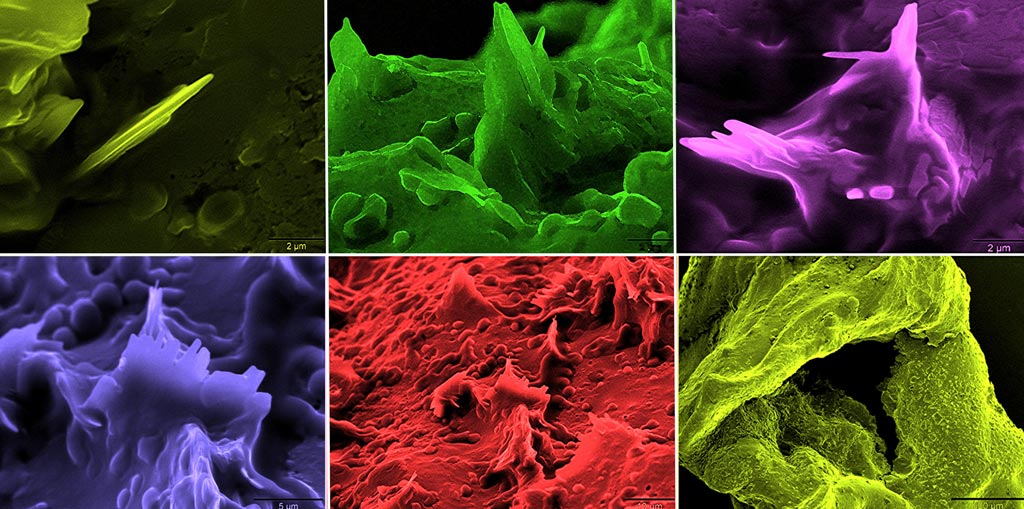Cholesterol Crystals Suggest Looming Heart Attack
|
By HospiMedica International staff writers Posted on 28 Aug 2017 |

Image: Cholesterol crystals arising from within the artery wall, causing tearing and damage (Photo courtesy of MSU).
Cholesterol crystals that pierce the arterial plaque and intima trigger local and systemic inflammation that can lead to a myocardial infarction (MI), according to a new study.
Researchers at Michigan State University (MSU; East Lansing, USA) conducted a study involving 240 emergency room patients who died of MI in order to examine the role of cholesterol in the crystallized state on atherosclerosis and plaque rupture, and its contribution to acute MI and stroke. To visualize the cholesterol crystals, the researchers processed the tissue without ethanol. They found that cholesterol expands when crystallizing from the liquid to the solid state, which is the presumed cause of plaque rupture by the sharp-tipped crystals growing out of the plaque’s necrotic core.
The researchers found that in patients who died of MI, culprit coronary lesions had extensive cholesterol crystals perforating the fibrous cap and intima, while atherosclerotic patients who died of other causes did not have such perforating crystals. They also found that cholesterol crystals traveling downstream from the plaque rupture site can scrape the endothelium and promote vasospasm, and that cholesterol crystals lodging into the muscle can trigger an inflammation with necrosis, independent of circulatory compromise or ischemia. The study was published on May 1, 2017, in Cardiovascular Innovations and Applications.
“In previous studies, we showed that when cholesterol goes from a liquid to a solid, or crystal state, it expands in volume like ice and water. This expansion inside the wall of the artery can tear it and block blood flow causing a heart attack or stroke,” said senior author George Abela, MD, chief cardiologist at MSU. “Since cholesterol crystals form very early in the process of heart disease, with great potential to aggravate atherosclerosis, we can target new therapies by reducing cholesterol crystal deposits early on or use an inhibitor to block the inflammatory biomarker.”
Cholesterol is a modified steroid in the form of a lipid molecule, biosynthesized by all animal cells, and is an essential structural component comprising up to 30% of all cell membranes. Cholesterol also serves as a precursor for the biosynthesis of steroid hormones, bile acid, and vitamin D.
Related Links:
Michigan State University
Researchers at Michigan State University (MSU; East Lansing, USA) conducted a study involving 240 emergency room patients who died of MI in order to examine the role of cholesterol in the crystallized state on atherosclerosis and plaque rupture, and its contribution to acute MI and stroke. To visualize the cholesterol crystals, the researchers processed the tissue without ethanol. They found that cholesterol expands when crystallizing from the liquid to the solid state, which is the presumed cause of plaque rupture by the sharp-tipped crystals growing out of the plaque’s necrotic core.
The researchers found that in patients who died of MI, culprit coronary lesions had extensive cholesterol crystals perforating the fibrous cap and intima, while atherosclerotic patients who died of other causes did not have such perforating crystals. They also found that cholesterol crystals traveling downstream from the plaque rupture site can scrape the endothelium and promote vasospasm, and that cholesterol crystals lodging into the muscle can trigger an inflammation with necrosis, independent of circulatory compromise or ischemia. The study was published on May 1, 2017, in Cardiovascular Innovations and Applications.
“In previous studies, we showed that when cholesterol goes from a liquid to a solid, or crystal state, it expands in volume like ice and water. This expansion inside the wall of the artery can tear it and block blood flow causing a heart attack or stroke,” said senior author George Abela, MD, chief cardiologist at MSU. “Since cholesterol crystals form very early in the process of heart disease, with great potential to aggravate atherosclerosis, we can target new therapies by reducing cholesterol crystal deposits early on or use an inhibitor to block the inflammatory biomarker.”
Cholesterol is a modified steroid in the form of a lipid molecule, biosynthesized by all animal cells, and is an essential structural component comprising up to 30% of all cell membranes. Cholesterol also serves as a precursor for the biosynthesis of steroid hormones, bile acid, and vitamin D.
Related Links:
Michigan State University
Latest Critical Care News
- Ingestible Capsule Monitors Intestinal Inflammation
- Wireless Implantable Sensor Enables Continuous Endoleak Monitoring
- Pulse Oximeter Index Offers Non-Invasive Guides for Fluid Therapy
- Wearable Patch for Early Skin Cancer Detection to Reduce Unnecessary Biopsies
- 'Universal' Kidney to Match Any Blood Type
- Light-Based Technology to Measure Brain Blood Flow Could Diagnose Stroke and TBI
- AI Heart Attack Risk Assessment Tool Outperforms Existing Methods
- Smartphone Imaging System Enables Early Oral Cancer Detection
- Swallowable Pill-Sized Bioprinter Treats GI Tract Injuries

- Personalized Brain “Pacemakers” Could Help Patients with Hard-To-Treat Epilepsy
- Microscopic DNA Flower Robots to Enable Precision Medicine Delivery
- Origami Robots to Deliver Medicine Less Invasively and More Effectively
- Improved Cough-Detection Technology Aids Health Monitoring
- AI Identifies Children in ER Likely to Develop Sepsis Within 48 Hours
- New Radiofrequency Therapy Slows Glioblastoma Growth
- Battery-Free Wireless Multi-Sensing Platform Revolutionizes Pressure Injury Detection
Channels
Surgical Techniques
view channel
Robotic Assistant Delivers Ultra-Precision Injections with Rapid Setup Times
Age-related macular degeneration (AMD) is a leading cause of blindness worldwide, affecting nearly 200 million people, a figure expected to rise to 280 million by 2040. Current treatment involves doctors... Read more
Minimally Invasive Endoscopic Surgery Improves Severe Stroke Outcomes
Intracerebral hemorrhage, a type of stroke caused by bleeding deep within the brain, remains one of the most challenging neurological emergencies to treat. Accounting for about 15% of all strokes, it carries... Read morePatient Care
view channel
Revolutionary Automatic IV-Line Flushing Device to Enhance Infusion Care
More than 80% of in-hospital patients receive intravenous (IV) therapy. Every dose of IV medicine delivered in a small volume (<250 mL) infusion bag should be followed by subsequent flushing to ensure... Read more
VR Training Tool Combats Contamination of Portable Medical Equipment
Healthcare-associated infections (HAIs) impact one in every 31 patients, cause nearly 100,000 deaths each year, and cost USD 28.4 billion in direct medical expenses. Notably, up to 75% of these infections... Read more
Portable Biosensor Platform to Reduce Hospital-Acquired Infections
Approximately 4 million patients in the European Union acquire healthcare-associated infections (HAIs) or nosocomial infections each year, with around 37,000 deaths directly resulting from these infections,... Read moreFirst-Of-Its-Kind Portable Germicidal Light Technology Disinfects High-Touch Clinical Surfaces in Seconds
Reducing healthcare-acquired infections (HAIs) remains a pressing issue within global healthcare systems. In the United States alone, 1.7 million patients contract HAIs annually, leading to approximately... Read moreHealth IT
view channel
Printable Molecule-Selective Nanoparticles Enable Mass Production of Wearable Biosensors
The future of medicine is likely to focus on the personalization of healthcare—understanding exactly what an individual requires and delivering the appropriate combination of nutrients, metabolites, and... Read moreBusiness
view channel
Philips and Masimo Partner to Advance Patient Monitoring Measurement Technologies
Royal Philips (Amsterdam, Netherlands) and Masimo (Irvine, California, USA) have renewed their multi-year strategic collaboration, combining Philips’ expertise in patient monitoring with Masimo’s noninvasive... Read more
B. Braun Acquires Digital Microsurgery Company True Digital Surgery
The high-end microsurgery market in neurosurgery, spine, and ENT is undergoing a significant transformation. Traditional analog microscopes are giving way to digital exoscopes, which provide improved visualization,... Read more
CMEF 2025 to Promote Holistic and High-Quality Development of Medical and Health Industry
The 92nd China International Medical Equipment Fair (CMEF 2025) Autumn Exhibition is scheduled to be held from September 26 to 29 at the China Import and Export Fair Complex (Canton Fair Complex) in Guangzhou.... Read more














